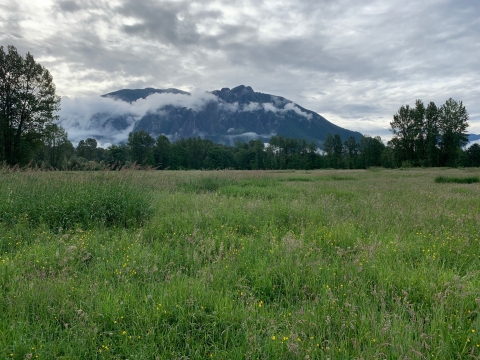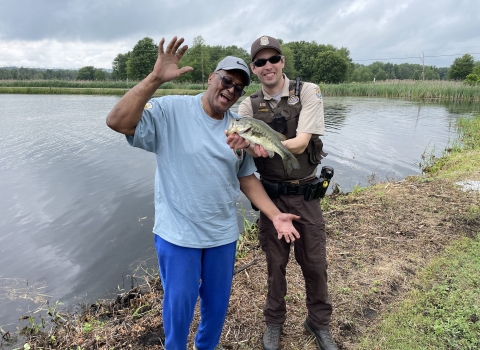Since time immemorial, Tribes have relied on their plant and animal relatives to support their way of life by providing food, clothing, and items of cultural use. Today, many Tribes commit financial resources and engage in partnerships to restore landscapes and conserve the species and resources in their care for the benefit of future generations.
Since 2001, the U.S. Fish and Wildlife Service’s Tribal Wildlife Grant program has provided opportunities for vital conservation projects on Tribal lands. The Service partners with Tribes to protect threatened and endangered species, restore habitat, and conduct research. The grant program has leveraged millions of dollars to sustain fish and wildlife and help Tribes maintain their heritage.
In 2022, eight Tribes in Oregon, Washington, and Idaho received a total of nearly $1.5 million for conservation projects. Many of these Tribes have been investing in these efforts for many years, and their continued funding reflects their success and dedication. The summaries below describe the selected projects.
1. Colville Confederated Tribes: Supporting the Return of Canada Lynx in North-Central Washington
The Colville Confederated Tribes are receiving funding to support the continued implementation of the Canada Lynx Augmentation project. This project is an international effort to live-trap and release lynx from British Columbia on the Colville Indian Reservation. The Tribe anticipates increases in both distribution and occurrence of lynx throughout the Kettle Range as well as in British Columbia and the Cascades. The continued funding of this project will allow Tribal biologists and partners to continue this significant work to return the endangered Canada lynx to the Kettle Range in north-central Washington. Carrying out this project allows the Tribe to manage a culturally significant species across state, federal and international boundaries and strengthen Tribal sovereignty.
2. Tulalip Tribes of Washington: Adaptive Salmon Restoration via Beaver Relocation within Tulalip Tribes Ancestral Lands
Through the Tulalip Beaver Project, beavers will be live-trapped from urban areas around Puget Sound. The beavers will be relocated to remote streams in the Snohomish and Stillaguamish watersheds on U.S. Forest Service land. By building dams at relocation sites, beavers will help protect, create, and restore vital aquatic, riparian riparian
Definition of riparian habitat or riparian areas.
Learn more about riparian , and wetland habitat for salmon and other native wildlife. Tulalip Beaver Project staff will monitor the relocation sites for beaver activity, changes in habitat, wildlife presence, and salmon spawning and rearing. The beaver dams will help increase salmon habitat and salmon populations while making the watersheds more resilient to the effects of climate change climate change
Climate change includes both global warming driven by human-induced emissions of greenhouse gases and the resulting large-scale shifts in weather patterns. Though there have been previous periods of climatic change, since the mid-20th century humans have had an unprecedented impact on Earth's climate system and caused change on a global scale.
Learn more about climate change .
3. Lummi Indian Business Council: South Fork Nooksack Cavanaugh Island Phase 2 Restoration Project
The Lummi Nation will use grant funding to restore river habitat in the South Fork Nooksack River in Skagit County. The goal is to restore early Chinook salmon spawning, rearing, and holding habitat to recover self-sustaining runs to harvestable levels. Installing engineered logjams, modeled after historic logjams, and restoring more than seven acres of riparian habitat will help recreate the natural landscape. The project enhances the benefits of the South Fork Chinook Rescue Program and a native broodstock broodstock
The reproductively mature adults in a population that breed (or spawn) and produce more individuals (offspring or progeny).
Learn more about broodstock hatchery program that already support salmon recovery. The project will also help lower water temperatures and benefit other threatened and endangered species, such as steelhead, bull trout, and other species of salmon.
4. Nez Perce Tribe: Evaluation and Planning for Sockeye Salmon Reintroduction to Wallowa Lake
With the help of Tribal Wildlife Grant funding, the Nez Perce Tribe will conduct research to accomplish the Tribe’s long-term goal of restoring a population of sockeye salmon to Wallowa Lake in eastern Oregon. Sockeye salmon disappeared from Wallowa Lake in the early 1900s and restoring the fish to the ancestral lands of the Tribe is of deep importance. Recent renovations to the Wallowa Lake Dam have been proposed. The goal is to rehabilitate the dam to make it fully operational and ultimately restore fish passage fish passage
Fish passage is the ability of fish or other aquatic species to move freely throughout their life to find food, reproduce, and complete their natural migration cycles. Millions of barriers to fish passage across the country are fragmenting habitat and leading to species declines. The U.S. Fish and Wildlife Service's National Fish Passage Program is working to reconnect watersheds to benefit both wildlife and people.
Learn more about fish passage to Wallowa Lake. Although renovating the dam would restore fish passage to and from the lake, important information gaps remain related to sockeye salmon reintroduction. With this grant, Tribal staff will research four critical information gaps:
Migration corridor conditions for adult and juvenile sockeye salmon.
Impacts of non-native species in Wallowa Lake.
Effects of lake productivity on juvenile sockeye growth and recruitment.
Condition of existing spawning habitat in the lake and its tributaries.
This project will compile a combination of existing data, collect new data in the field and laboratory, and analyze and summarize learned information.
5. Confederated Tribes of Coos, Lower Umpqua, and Siuslaw Indians: Tribal Conservation and Management Plan Development
The Tribe will partner with the U.S. Fish and Wildlife Service, National Marine Fisheries Service, other Tribes, local partners, and consultants to develop a Tribal Conservation and Management Plan that will tier to the Tribes’ Forest Management Plan. The plan will provide a framework for managing Tribal forest lands while promoting science-driven management principles for sensitive fish and wildlife species. Additionally, the plan will be developed using the best available scientific and commercial data and traditional ecological knowledge.
6. Quinault Indian Nation: Certain or Safe? Or Both? Testing a Novel Approach to Elk Abundance Estimation Using Established Methodology
Roosevelt elk are a crucial component of the cultural, spiritual, and physical health of the Quinault community. Traditionally, elk populations in dense coastal temperate rainforest have been monitored using direct capture and helicopter surveys. Newer, safer methods for estimating large mammal abundance via camera trapping have been developed but are untested for accuracy at estimating elk abundance in this environment. With the help of Tribal Wildlife Grant funding, the Tribe will estimate elk abundance on the Quinault Indian Reservation using both an established aerial survey approach and a novel, non-invasive camera trapping approach. Population estimates generated from the different methods will be compared and model performance will be evaluated. A determination of the appropriateness of the camera trapping methods for estimating elk abundance in coastal temperate rainforests will be made, and a long-term monitoring protocol for elk on the Quinault Indian Reservation will be recommended.
7. Snoqualmie Indian Tribe: Snoqualmie Prairie Restoration – Phase 1
Snoqualmie Prairie is important to the Snoqualmie Indian Tribe, both from ecological and cultural aspects. Today, approximately 390 acres of prairie remain, but in a highly degraded and fractured state. The Snoqualmie Prairie area currently has approximately 400 elk that are highly dependent on these areas for survival. The Tribe is partnering with King County Parks, the cities of Snoqualmie and North Bend, and Meadowbrook Farms to restore Snoqualmie Prairie habitat. The largest contiguous prairie remnant is Meadowbrook Farm, an area of more than 200 acres along Kimball Creek, jointly owned by the cities of North Bend and Snoqualmie. These lands are heavily infested with invasive plants and weeds, and many of the native plants historically cultivated by the Snoqualmie Tribe are no longer present. This Tribal Wildlife Grant will fund phase 1, a pilot habitat restoration project, and includes:
Restoring approximately 3.5 acres of native Garry oak meadow
Planting approximately 1.8 acres of native meadow grasses and forbes
Removing invasive species invasive species
An invasive species is any plant or animal that has spread or been introduced into a new area where they are, or could, cause harm to the environment, economy, or human, animal, or plant health. Their unwelcome presence can destroy ecosystems and cost millions of dollars.
Learn more about invasive species from approximately two acresCollecting critical data for successfully expanding meadow restoration to dozens of additional acres in the future
Providing a blueprint for preserving important and rare meadow habitat critical to the region.
Preserving open meadow habitat critical to elk and many other species.
Providing an opportunity for Tribal members and community members to directly engage in restoring a landscape of great cultural importance to the Snoqualmie Tribe.
8. Coquille Indian Tribe: Coquille River Subbasin Plan Review and Update
The Coquille Indian Tribe will use Tribal Wildlife Grant funds to coordinate and conduct a comprehensive review and update to the Coquille River Subbasin Plan prepared for the National Marine Fisheries Service in 2007. The plan has served to guide prioritization of project-scale restoration activities for the benefit of native fishes in Southwestern Oregon’s Coquille River watershed. Successful completion of this project will result in an up-to-date planning tool for the benefit of restoration practitioners and fisheries managers in the Coquille River watershed, and will benefit fish and wildlife resources and users of the watershed.





